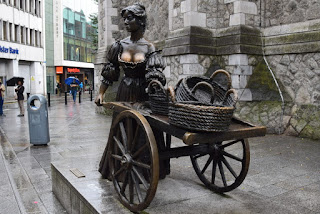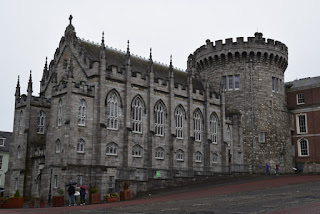After a pretty rough two days at sea to Iceland we
awoke to a cloudy day that in the afternoon turned glorious. We were eager to
hop ashore and explore the capital Reykjavik.
We started off at a museum which reflected early
settlement. Houses initially comprised stones which were bedded on sods. This
made for a very snug and draft free structure. Sods and grass made up the roof
– all very environmentally friendly.
With trade came timber and metal sheets. This enabled
higher buildings with roof space for bedrooms.
It was a pretty cold 5°C which with a wind chill factor
encouraged inside tours. The sheep had pens but were clearly comfortable in
their thick wool. Less comfortable seemed to be the four horns. The lower ones
look like they could be in growing neck horns (our ingrowing toe
nail equivalent?)
The short arranged tour included a stop at Hallgrímskirkja
Church. This is a most unusual but attractive design.
Our free time afternoon walk under blue skies gave a
different perspective. Unfortunately the reinforcement cover on much of the façade was inadequate and substantial labour intensive remedial work was being undertaken.
Inside was a magnificent organ (which less attractively
was being tuned!). It has some 5275 pipes and unusually some are horizontal,
as well as two playing positions, one somewhat conventionally in amongst the
pipes and the other remote and on the church floor which I am guessing must be
digitally connected.
At the end of the morning tour we found ourselves
outside the Harpa Concert Hall. This is a huge building (especially given the
Icelandic population is only just over 330,000). The construction work came to
a grinding halt due to the financial crisise but in 2008 the Icelandic
government decided to fund its completion (presumably the first part was
effectively free!) The façade with some windows being coloured catches the eye.
The internal space is just as effective however the
main hall can only be accessed as a separate tour (or when viewing a show).
Iceland is a challenge for shipping. Towards the
harbour was a series of maps of Iceland. Each reflected a period of time and
shows which ships foundered during the period. This map (as an example) shows
the period from 1970 – 79. 100 ships foundered; a staggering loss of people,
ships and goods.
The old town was a joy to walk around – I suspect
biking would also work…
Our departure was a glorious warm evening – this was
one of the first ever buildings on the island.
The setting sun also encouraged reflection.
After a further (quite rough) day at sea we approached
Greenland and glaciers. It is vast and easily surpasses the size of Australia.
Once we entered Prince Christian Sound we were treated
to close ups of three sea glaciers.
Some of the icebergs that were spawned (well calved) are huge – this was
as high as our ship.
We were also fortunate to see two of the glaciers
calving.
This one, given its cave roof, gave an enormous reflected
roar.
About one third through the sound (which is about 100 kms long) we came across a small village (Augpilagton) and convenient natural harbour.
It was not surprising to see what was on the menu……
After a short overnight trip up the first part of the
West coast we turned inland to Narsarsuaq. We actually had to shorten the journey
and anchor at Narsaq as the ice flows were too numerous to navigate further. After
anchoring we took a small boat ride to take in some of the numerous icebergs.
The colours, reflections and melding with the skies of the early morning gave
rise to several hundred photos. Here is an uninterrupted selection.
Just awesome.
In the afternoon we went on a bit of a hike and gained
some wonderful views on what became a pretty hot day. The contrasting blues of
the sea and sky with white icebergs and golden colours of the plant life was
stunning.
This is the smallest house in the village.
While on the top of the hill the church stood out.
Surprisingly inside the décor was Greece blue and white.
Mind you the local Inuit girls are just as giggly as anywhere else when it comes to having their photo taken.
With that it was back to Silver Whisper looking gracious
in the afternoon light waiting to head off to Canada.
There is little doubt that our two days in Greenland
were the scenic high point of this trip and we were spoilt with perfect weather.
In future we also anticipate a week in Iceland is warranted so we can see the fire and
ice of the volcanoes and hot springs. We will probably travel by air though!





























































